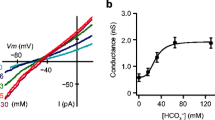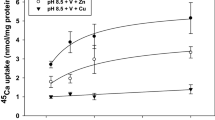Abstract
In Formica Malpighian tubules KCl secretion is driven by a V-type H+ ATPase in the luminal membrane in parallel with a H+/K+ antiporter. The effect of the protonophore dinitrophenol (DNP) was investigated on the isolated, symmetrically perfused tubule. DNP was applied in two different concentrations: 0.2 mmol/l and 1 mmol/l. The effects were fast and rapidly reversible. The equivalent short-circuit current (I sc) was reduced significantly to respectively 25±3% Cn=4) and −3±7% (n=11) of the control value when 0.2 mmol/ l or 1 mmol/l was added to the bath. When 1 mmol/l DNP was applied the transepithelial resistance (R te) decreased significantly to 74±11% of the control value (n=11), and the luminal over basolateral voltage divider ratio (VDR), providing an estimate of luminal over basolateral membrane resistance, decreased to 37±12% of the control (n=6). A concentration of 1 mmol/l DNP was also applied from the lumen. The decrease in I sc was significant, but much less pronounced (74±5% of control; n=6) and no significant changes in R te and VDR were observed. It is argued that, when the concentration in the bath is high enough, DNP may cross the cell and have a protonophoric effect not only on the mitochondria but also across the luminal cell membrane explaining the drop in transepithelial and in relative luminal membrane resistance. The diminished effectiveness of DNP, when applied from the luminal side, suggests that the luminal membrane is somehow less permeable to toxic substances, but that DNP very rapidly enters the cell via the basolateral membrane and may bring about an initial protonophoric effect across this membrane.
Similar content being viewed by others
References
Beauwens R, Al-Awqati Q (1976) Active H+-transport in the turtle urinary bladder. J Gen Physiol 68:421–439
Boulpaep E, Giebisch G (1978) Electrophysiological measurements of the renal tubule. Methods Pharmacol 4:165–193
Dijkstra S, Lohrmann E, Steels P, Greger R (1992) The isolated perfused Malpighian tubule: shunt selectivity and effects of DNP and luminal pH. Pflügers Arch 242[Suppl 1]:R62
Dijkstra S, Lohrmann E, Steels P, Van Kerkhove E, Greger R (1993) Two effects of DNP on the isolated Malpighian tubule of the ant. Arch Int Physiol Biochim 101: P1
Dijkstra S, Lohrmann E, Steels P, Greger R (1994) Electrical properties of the isolated, in vitro perfused Malpighian tubule of the ant, the Cl−-pathway. Cell Physiol Biochem 4:19–30
Dijkstra S, Lohrmann E, Van Kerkhove E, Greger R (1994) Characteristics of the luminal pump in the Malpighian tubules of the ant. Renal Physiol Biochem 17:27–39
Garayoa M, Villaro AC, Montuenga L, Sesma P (1992) Malpighian tubules of Formica polyctena (Hymenoptera): light and electron microscopic study. J Morphol 214:159–171
Godfraind JM, Kawamura H, Krnjevic K, Pumain R (1971) Actions of dinitrophenol and some other metabolic inhibitors on cortical neurons ? J Physiol (Lond) 215:199–222
Greger R, Hampel W (1981) A modified system for in vitro perfusion of isolated renal tubules. Pflügers Arch 389:175–176
Greger R, Schlatter E, Lang F (1983) Evidence for electroneutral sodium chloride cotransport in the cortical thick ascending limb of Henle's loop of rabbit kidney. Pflügers Arch 396:308–314
Harvey BJ, Thomas SR, Ehrenfeld J (1988) Intracellular pH controls cell membrane Na+ and K+ conductances and transport in frog skin epithelium. J Gen Physiol 92:767–791
Isaacson LC, Nicolson SW, Fisher DW (1989) Electrophysiological and cable parameters of perfused beetle Malpighian tubules. Am J Physiol 257:R1190-R1198
Leyssens A, Steels P, Lohrmann E, Weltens R, Van Kerkhove E (1992) Intrinsic regulation of K+ transport in Malpighian tubules (Formica): electrophysiological evidence. J Insect Physiol 38:431–446
Leyssens A, Zhang SL, Van Kerkhove E, Steels P (1993) Both dinitrophenol and Ba2+ reduce KCl secretion in Malpighian tubules of Formica: the role of the apical H+ and K+ concentration gradient. J Insect Physiol 39:1061–1073
Loomis WF, Lippman F (1948) Reversible inhibition of the coupling between phosphorylation and oxidation. J Biol Chem 172:807–808
McLaughlin SGA, Dilger JP (1980) Transport of protons across membranes by weak acids. Physiol Rev 60:825–863
Mitchell P (1961) Coupling of phosphorylation to electron and hydrogen transfer by a chemiosmotic type of mechanism. Nature 191:144–148
Motais R, Sola F, Cousin JL (1978) Uncouplers of oxidative phosphorylation, a structure-activity study of their inhibitory effect on passive chloride permeability. Biochim Biophys Acta 510:20–207
Nicolson SW, Isaacson LC (1987) Transepithelial and intracellular potentials in isolated Malpighian tubules of tenebrionid beetle. Am J Physiol 252:F645-F653
O'Donnell MJ, Machin J (1991) Ion activities and electrochemical gradients in the mealworm rectal complex. J Exp Biol 155:375–402
Pannabecker TL, Aneshansley DJ, Beyenbach KW (1992) Unique physiological effects of dinitrophenol in Malpighian tubules. Am J Physiol 263:R609-R614
Roos A, Boron WF (1981) Intracellular pH. Physiol Rev 61:296–434
Van Kerkhove E, Weltens R, Roinel N, De Decker N (1989) Haemolymph composition in Formica (Hymenoptera) and urine formation by the short isolated Malpighian tubules: electrochemical gradients for ion transport. J Insect Physiol 35:991–1003
Welling LW, Welling DJ (1975) Surface areas of brush border and lateral cell walls in the rabbit proximal nephron. Kidney Int 8:343–348
Weltens R, Leyssens A, Zhang SL, Lohrmann E, Steels P, Van Kerkhove E (1992) Unmasking of the apical electrogenic Hpump in isolated Malpighian tubules (Formica polyctena) by the use of barium. Cell Physiol Biochem 2:101–116
Williams JC, Beyenbach KW (1984) Differential effects of secretagogues on the electrophysiology of the Malpighian tubules of the yellow fever mosquito. J Comp Physiol 154:301–309
Zhang SL, Leyssens A, Van Kerkhove E, Weltens R, Van Driessche W, Steels P (1994) Electrophysiological evidence for the presence of an apical H+-ATPase in Malpighian tubules of Formica polyctena: intracellular and luminal pH measurements. Pflügers Arch 426:288–295
Author information
Authors and Affiliations
Rights and permissions
About this article
Cite this article
Dijkstra, S., Lohrmann, E., Van Kerkhove, E. et al. Effects of dinitrophenol on active-transport processes and cell membranes in the Malpighian tubule of Formica . Pflügers Arch 428, 150–156 (1994). https://doi.org/10.1007/BF00374852
Received:
Revised:
Accepted:
Issue Date:
DOI: https://doi.org/10.1007/BF00374852




